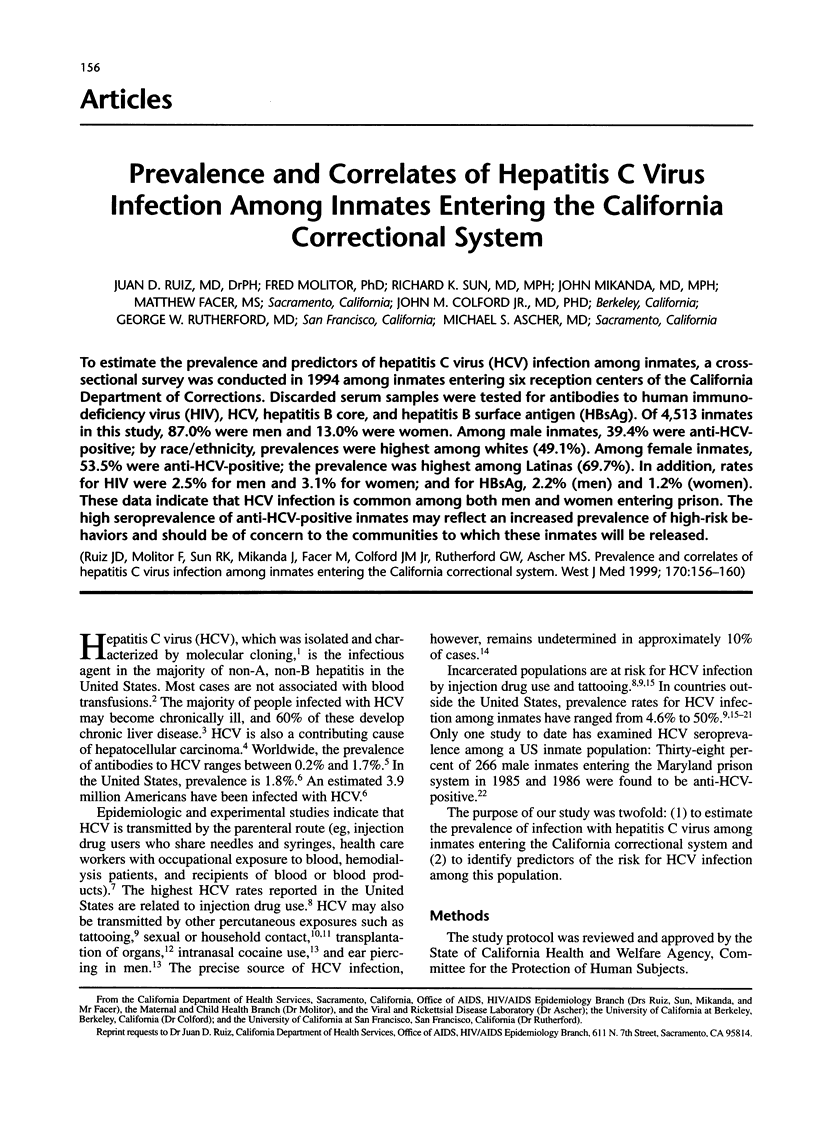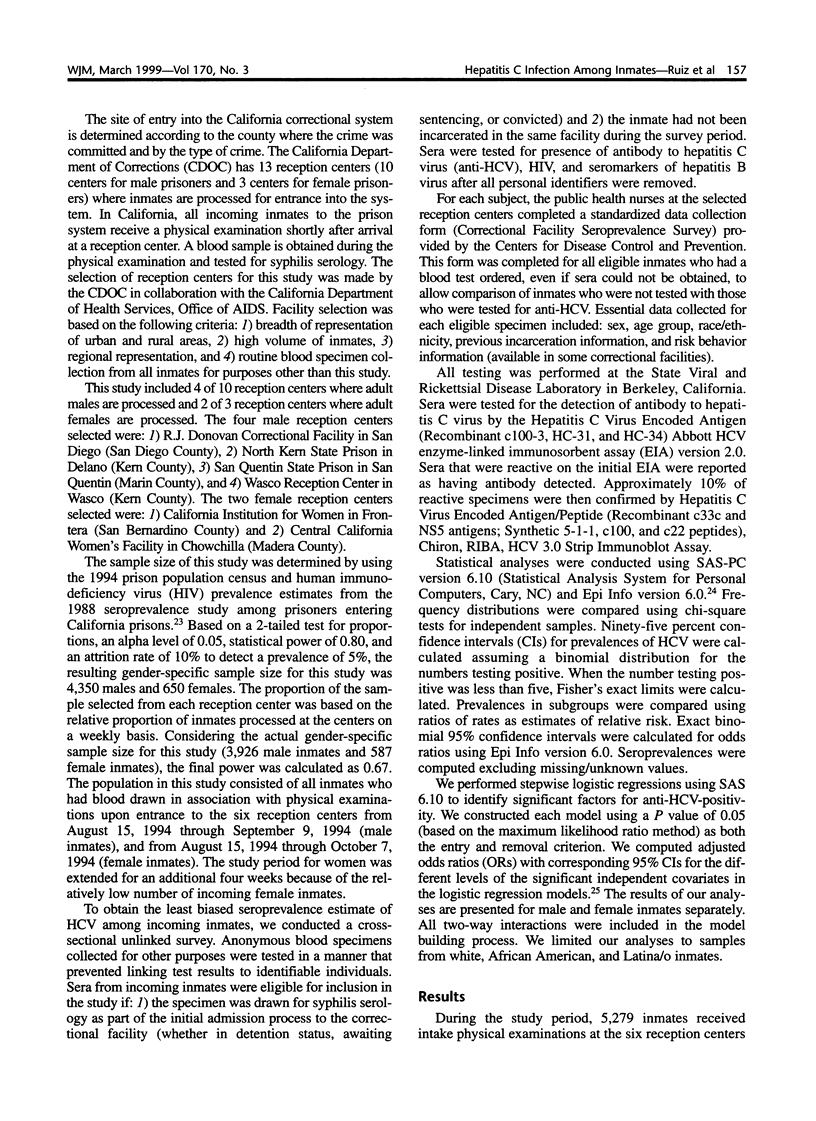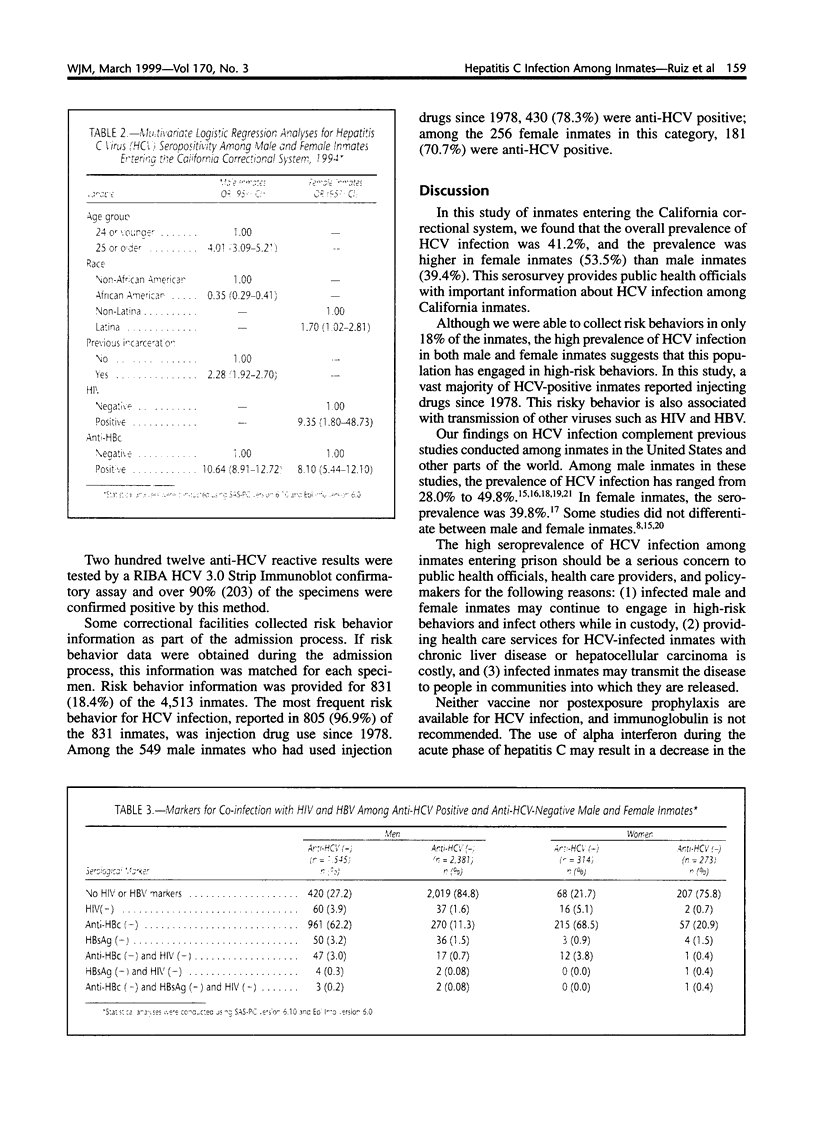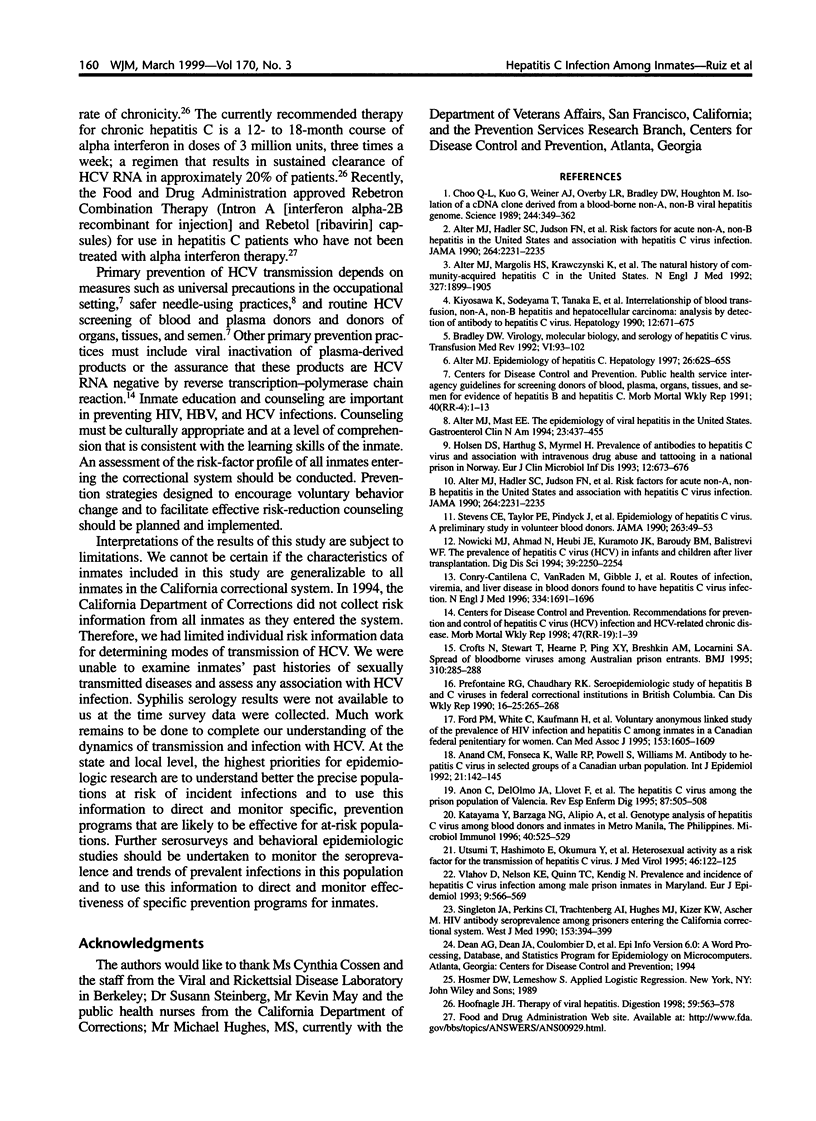Abstract
To estimate the prevalence and predictors of hepatitis C virus (HCV) infection among inmates, a cross-sectional survey was conducted in 1994 among inmates entering six reception centers of the California Department of Corrections. Discarded serum samples were tested for antibodies to human immunodeficiency virus (HIV), HCV, hepatitis B core, and hepatitis B surface antigen (HBsAg). Of 4,513 inmates in this study, 87.0% were men and 13.0% were women. Among male inmates, 39.4% were anti-HCV-positive; by race/ethnicity, prevalences were highest among whites (49.1%). Among female inmates, 53.5% were anti-HCV-positive; the prevalence was highest among Latinas (69.7%). In addition, rates for HIV were 2.5% for men and 3.1% for women; and for HBsAg, 2.2% (men) and 1.2% (women). These data indicate that HCV infection is common among both men and women entering prison. The high seroprevalence of anti-HCV-positive inmates may reflect an increased prevalence of high-risk behaviors and should be of concern to the communities to which these inmates will be released.
Full text
PDF




Selected References
These references are in PubMed. This may not be the complete list of references from this article.
- Alter M. J. Epidemiology of hepatitis C. Hepatology. 1997 Sep;26(3 Suppl 1):62S–65S. doi: 10.1002/hep.510260711. [DOI] [PubMed] [Google Scholar]
- Alter M. J., Hadler S. C., Judson F. N., Mares A., Alexander W. J., Hu P. Y., Miller J. K., Moyer L. A., Fields H. A., Bradley D. W. Risk factors for acute non-A, non-B hepatitis in the United States and association with hepatitis C virus infection. JAMA. 1990 Nov 7;264(17):2231–2235. [PubMed] [Google Scholar]
- Alter M. J., Hadler S. C., Judson F. N., Mares A., Alexander W. J., Hu P. Y., Miller J. K., Moyer L. A., Fields H. A., Bradley D. W. Risk factors for acute non-A, non-B hepatitis in the United States and association with hepatitis C virus infection. JAMA. 1990 Nov 7;264(17):2231–2235. [PubMed] [Google Scholar]
- Alter M. J., Margolis H. S., Krawczynski K., Judson F. N., Mares A., Alexander W. J., Hu P. Y., Miller J. K., Gerber M. A., Sampliner R. E. The natural history of community-acquired hepatitis C in the United States. The Sentinel Counties Chronic non-A, non-B Hepatitis Study Team. N Engl J Med. 1992 Dec 31;327(27):1899–1905. doi: 10.1056/NEJM199212313272702. [DOI] [PubMed] [Google Scholar]
- Alter M. J., Mast E. E. The epidemiology of viral hepatitis in the United States. Gastroenterol Clin North Am. 1994 Sep;23(3):437–455. [PubMed] [Google Scholar]
- Anand C. M., Fonseca K., Walle R. P., Powell S., Williams M. Antibody to hepatitis C virus in selected groups of a Canadian urban population. Int J Epidemiol. 1992 Feb;21(1):142–145. doi: 10.1093/ije/21.1.142. [DOI] [PubMed] [Google Scholar]
- Añn C., del Olmo J. A., Llovet F., Serra M. A., Gilabert S., Rodríguez F., Rodrigo J. M. Virus C de la hepatitis entre la población penitenciaria de Valencia. Rev Esp Enferm Dig. 1995 Jul;87(7):505–508. [PubMed] [Google Scholar]
- Bradley D. W. Virology, molecular biology, and serology of hepatitis C virus. Transfus Med Rev. 1992 Apr;6(2):93–102. doi: 10.1016/s0887-7963(92)70159-x. [DOI] [PubMed] [Google Scholar]
- Choo Q. L., Kuo G., Weiner A. J., Overby L. R., Bradley D. W., Houghton M. Isolation of a cDNA clone derived from a blood-borne non-A, non-B viral hepatitis genome. Science. 1989 Apr 21;244(4902):359–362. doi: 10.1126/science.2523562. [DOI] [PubMed] [Google Scholar]
- Conry-Cantilena C., VanRaden M., Gibble J., Melpolder J., Shakil A. O., Viladomiu L., Cheung L., DiBisceglie A., Hoofnagle J., Shih J. W. Routes of infection, viremia, and liver disease in blood donors found to have hepatitis C virus infection. N Engl J Med. 1996 Jun 27;334(26):1691–1696. doi: 10.1056/NEJM199606273342602. [DOI] [PubMed] [Google Scholar]
- Crofts N., Stewart T., Hearne P., Ping X. Y., Breshkin A. M., Locarnini S. A. Spread of bloodborne viruses among Australian prison entrants. BMJ. 1995 Feb 4;310(6975):285–288. doi: 10.1136/bmj.310.6975.285. [DOI] [PMC free article] [PubMed] [Google Scholar]
- Ford P. M., White C., Kaufmann H., MacTavish J., Pearson M., Ford S., Sankar-Mistry P., Connop P. Voluntary anonymous linked study of the prevalence of HIV infection and hepatitis C among inmates in a Canadian federal penitentiary for women. CMAJ. 1995 Dec 1;153(11):1605–1609. [PMC free article] [PubMed] [Google Scholar]
- Holsen D. S., Harthug S., Myrmel H. Prevalence of antibodies to hepatitis C virus and association with intravenous drug abuse and tattooing in a national prison in Norway. Eur J Clin Microbiol Infect Dis. 1993 Sep;12(9):673–676. doi: 10.1007/BF02009378. [DOI] [PubMed] [Google Scholar]
- Hoofnagle J. H. Therapy of viral hepatitis. Digestion. 1998 Aug;59(5):563–578. doi: 10.1159/000007532. [DOI] [PubMed] [Google Scholar]
- Katayama Y., Barzaga N. G., Alipio A., Soetjipto, Doi H., Ishido S., Hotta H. Genotype analysis of hepatitis C virus among blood donors and inmates in Metro Manila, The Philippines. Microbiol Immunol. 1996;40(7):525–529. doi: 10.1111/j.1348-0421.1996.tb01104.x. [DOI] [PubMed] [Google Scholar]
- Kiyosawa K., Sodeyama T., Tanaka E., Gibo Y., Yoshizawa K., Nakano Y., Furuta S., Akahane Y., Nishioka K., Purcell R. H. Interrelationship of blood transfusion, non-A, non-B hepatitis and hepatocellular carcinoma: analysis by detection of antibody to hepatitis C virus. Hepatology. 1990 Oct;12(4 Pt 1):671–675. doi: 10.1002/hep.1840120409. [DOI] [PubMed] [Google Scholar]
- Nowicki M. J., Ahmad N., Heubi J. E., Kuramoto I. K., Baroudy B. M., Balistreri W. F. The prevalence of hepatitis C virus (HCV) in infants and children after liver transplantation. Dig Dis Sci. 1994 Oct;39(10):2250–2254. doi: 10.1007/BF02090380. [DOI] [PubMed] [Google Scholar]
- Préfontaine R. G., Chaudhary R. K. Seroepidemiologic study of hepatitis B and C viruses in federal correctional institutions in British Columbia. Can Dis Wkly Rep. 1990 Dec 29;16(52):265–266. [PubMed] [Google Scholar]
- Singleton J. A., Perkins C. I., Trachtenberg A. I., Hughes M. J., Kizer K. W., Ascher M. HIV antibody seroprevalence among prisoners entering the California correctional system. West J Med. 1990 Oct;153(4):394–399. [PMC free article] [PubMed] [Google Scholar]
- Stevens C. E., Taylor P. E., Pindyck J., Choo Q. L., Bradley D. W., Kuo G., Houghton M. Epidemiology of hepatitis C virus. A preliminary study in volunteer blood donors. JAMA. 1990 Jan 5;263(1):49–53. [PubMed] [Google Scholar]
- Utsumi T., Hashimoto E., Okumura Y., Takayanagi M., Nishikawa H., Kigawa M., Kumakura N., Toyokawa H. Heterosexual activity as a risk factor for the transmission of hepatitis C virus. J Med Virol. 1995 Jun;46(2):122–125. doi: 10.1002/jmv.1890460207. [DOI] [PubMed] [Google Scholar]
- Vlahov D., Nelson K. E., Quinn T. C., Kendig N. Prevalence and incidence of hepatitis C virus infection among male prison inmates in Maryland. Eur J Epidemiol. 1993 Sep;9(5):566–569. doi: 10.1007/BF00209538. [DOI] [PubMed] [Google Scholar]


